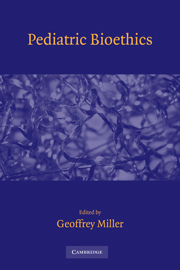Book contents
- Frontmatter
- Contents
- Contributors
- Preface
- A THE FOUNDATION: THEORY AND PRINCIPLES
- B GENETICS AND THE NEWBORN
- C THERAPIES
- 12 Rationality, Personhood, and Peter Singer on the Fate of Severely Impaired Infants
- 13 The Ethics of Controlling Reproduction in a Population with Mental Disabilities
- 14 Pediatric Innovative Surgery
- 15 Conjoined Twins
- 16 Ethics and Immunization
- 17 Psychotropic Drug Use in Children: The Case of Stimulants
- D END OF LIFE
- Index
15 - Conjoined Twins
Published online by Cambridge University Press: 07 May 2010
- Frontmatter
- Contents
- Contributors
- Preface
- A THE FOUNDATION: THEORY AND PRINCIPLES
- B GENETICS AND THE NEWBORN
- C THERAPIES
- 12 Rationality, Personhood, and Peter Singer on the Fate of Severely Impaired Infants
- 13 The Ethics of Controlling Reproduction in a Population with Mental Disabilities
- 14 Pediatric Innovative Surgery
- 15 Conjoined Twins
- 16 Ethics and Immunization
- 17 Psychotropic Drug Use in Children: The Case of Stimulants
- D END OF LIFE
- Index
Summary
The major ethical question we shall address in this chapter is, Under what conditions should conjoined twins be separated? Before we address that question directly, some background is in order.
Most types of conjoined twins appear to result from incomplete splitting of a single fertilized ovum, but some conformations termed “conjoined twinning” may involve a fusion of closely approximated embryos. The term “parasitic twin” refers to a conjoined twin lacking a functional brain. For example, “parasitic twins” sometimes appear in the form of extra arms or legs or as an essentially undeveloped embryo contained within the body of its fully grown twin (“fetus in fetu”). Nonparasitic conjoined twins have traditionally been classified according to where they are joined; thus, the nomenclature of conjoinment relies chiefly on the suffix pagos, a Greek term meaning “that which is fixed or joined.” For example, craniopagus twins are joined at the skull; thoracopagus twins share part of the chest wall and often the heart; pyopagus twins are usually back to back, joined at the rump; ischiopagus twins are joined at the sacrum and coccyx; and omphalopagus twins are joined at the abdomen and sternum. “Dicephalic” refers to twins who appear to have two heads on one body, though the actual number of appendages and internal organs varies from set to set. Indeed, the degree of shared anatomy and associated congenital malformations varies in all types of conjoined twins. The majority of conjoined twins throughout history have been stillborn or have died during the neonatal period because of congenital malformations. Today many are diagnosed prenatally and aborted.
Conjoined twins inevitably engender some degree of fascination and curiosity in others, at least upon first encounter.
- Type
- Chapter
- Information
- Pediatric Bioethics , pp. 203 - 218Publisher: Cambridge University PressPrint publication year: 2009

